Sylvia Jurgens
Rituals of Art Making
Tea, which keeps me sane and awake.
I am ritualistic about making tea in the morning before classes. My morning brews are either Jasmine, Green Tea, or Hot Cinnamon Spice. Tea has always been a huge part of my life; my mom always had Japanese tea prepared in the fridge, and I would often make tea for myself and my dad after coming home from school. It’s such a simple thing that a lot of people do, but I feel like that’s almost why it’s special to me. For example, making tea for your friends when they come over if they’re having a bad day shows that you care and you want them to be comfortable. Taking care of others and their needs are at the core of my identity. Tea has been a subconscious way of supporting myself and others. Along with making tea, note-taking also is second nature to me.
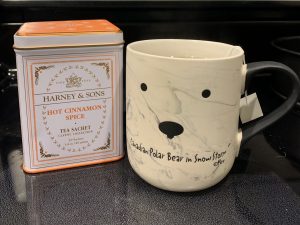
Note Taking, my saving grace.
My art process is completely centered around notetaking. I always sketch out some sort of idea on random paper or a designated sketchbook, and then I put my immediate thoughts down next to that. It’s really hard for me to gather all of my ideas before I forget them, so notetaking is crucial in both my creative process and my daily life. I’ve always been the person that takes really good notes during class and distributes them to everyone, and since that sort of thing doesn’t happen in the art world very often, I’ve translated that ability into my creative process. I retain information and collect my thoughts through notes, which makes it an essential part of my life. Without it, I don’t know if I could survive.
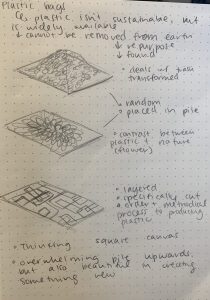
Notes from my sustainability project
What you’ll see typically from me is a series of thumbnails and maybe a few words about something that stood out or issues that I want to address and how the thumbnail accomplishes that.
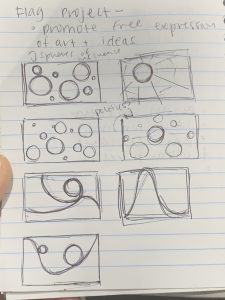
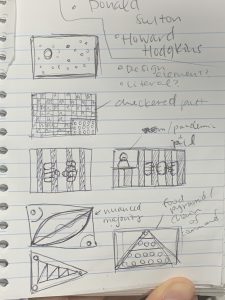
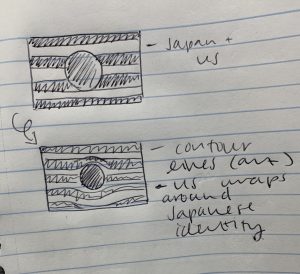
Thumbnails from my Flag Project
I was exploring the idea of my Japanese American identity, the coronavirus pandemic, the history, and the power dynamic within the United States.
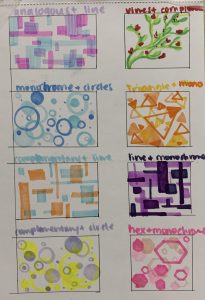
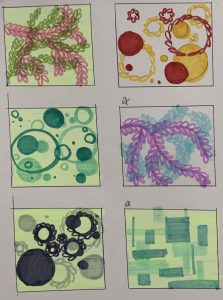
Thumbnails from my Postcard Project
In this project, I was playing with the idea of different color palettes to suit the repetitive shapes I was thinking of.
Since thumbnails are so ingrained into the process of painting and drawing, I think it just automatically became a permanent part of my artmaking process and organizational skills. Being able to generate rapid ideas and clearly see what works and what doesn’t helps me filter and move on faster, so that I can keep making progress towards an end goal.
Interacting with the Audience
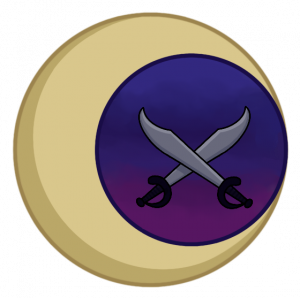
Vilevia YouTube Logo, Procreate, 2020.
I’m currently working on a logo for a YouTube channel that my friend and I are going to be collaborating on. Most of my work lets the audience interpret freely, so this was a bit of new territory for me. This logo is meant to represent me as a gamer, so I wanted to implement aspects of competitiveness and aesthetic. For the aesthetic and design aspect, I decided to use a moon shape with a pleasing palette, composed of blue, purple, pink, and yellow. For the competitive aspect, I wanted to use cutlasses because they are easily identified with the idea of attacking, and therefore are appropriate. The cutlasses and crescent shapes contrast each other to establish a balance between competition and having fun within gaming.
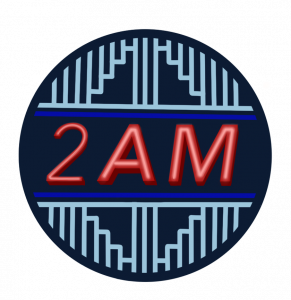
2 AM Movies YouTube Logo, Procreate, 2019.
The above is another logo I worked on for a friend, who wanted to start a YouTube channel about reviewing movies. Similar to the other logo, logic and simplicity is at the core of this design; it is meant for the viewer to have a rough idea of the channel while still being aesthetically pleasing. While creating this logo, I developed an iterative process that I continue to use while making graphics and logos.
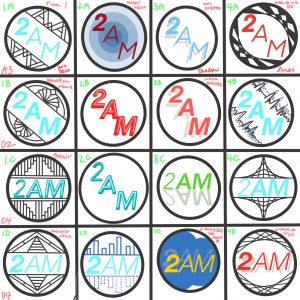
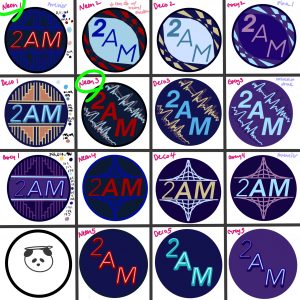

I create a type of grid with a wide variety of designs and continue to narrow it down through each iteration, either by myself or with a client. My general art-making process follows this same practice of making thumbnails and iterating but is perhaps less intense. I’ll essentially move on with an idea and start the main piece if I think the thumbnail idea is solid enough to work from.
Outside of logos, I generally like my pieces to be interpretive. I usually don’t have a reason for painting or drawing besides aesthetics and functionality, and I find that the art world tends to force meaning on things that don’t need to have any. I want my audience to have their own experience with my pieces; in a way, they are a part of the work as much as I am. I don’t think it’s right to claim that the “correct” way of interpreting my work is the way that I define it. It makes more sense to me that all possibilities and ideas are addressed and considered, and the audience will continue to bring that despite any choices I make, or when I deem the piece finished.
Recently I’ve been given projects in my Advanced Drawing class (ART 490) that have forced me to work abstractly with a starting idea. These works have a certain idea that focuses on my own beliefs or identity. However, my artwork has never been to provoke those same ideas into other people. The focus is always on how it looks, and how I feel about it.
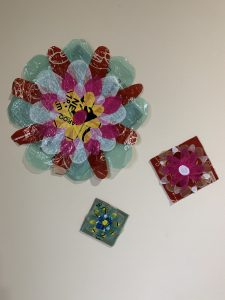
Sustainability Project
In this piece, I reflect on plastic consumption through take out and shopping bags. I turn the plastic bags I have into a flower, which both transforms the plastic into something beautiful and shows the contrast between nature and manufactured plastic.
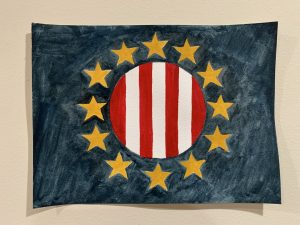
Japanese American Flag
In this piece, I reflect on how my Japanese identity is encompassed and is influenced by my American one. The red stripes act as jail bars for the circle that represents Japan. From a glance, this is a believable flag design that could fool someone into thinking it is for a real country.
Completeness and Aesthetic
The majority of all the work I have produced is complete. By that I mean that I consider the pieces to be finished – I probably won’t be touching them ever again. I have very few pieces that I started and abandoned, either due to lack of skill in a technical area or not knowing how to proceed. I seem to like structure, shapes, and completeness.
Complete is defined as “having all necessary parts, elements, or steps”, by Merriam Webster (Completeness). Completeness is subjective in the art world since you could continually work to improve pieces to your liking; a “finished” piece is a snapshot in time. I define completeness as the definition does – the individual parts, elements, and steps being present – and add my own requirements on top of that. That typically means that I want things to be realistic looking, but also clearly my work/style, and that I want any layperson to be able to tell that the work appears to be finished. I want there to be no doubts in my mind or the viewer’s mind that there are more lingering ideas around the piece.
Aesthetic is very important to me as well. Aesthetic is defined as “of, relating to, or dealing with aesthetics or the beautiful”, “artistic”, and “pleasing in appearance: attractive” by Merriam Webster (Aesthetic). Obviously, beauty is also subjective to different people, but I feel like in modern culture it’s clean, organized, colorful, and makes your brain happy to look at it. Simplicity and organization drive my work, which is reflected well in my logo designs as well as my compositional choices.
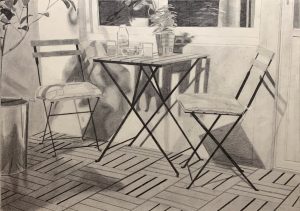
Ikea table and chairs. Graphite, 18″x24″, 2020.
For one of my drawing assignments (ART 390), I did a drawing of Ikea furniture because I had to work on cast shadows that week. When this promotional photo was taken, the photographer gave a lot of thought to the arrangement of the objects, and I also felt like there was this sort of calmness to the scene as well. Although for advertising purposes, this was considered a complete piece by both the photographer and their editor.
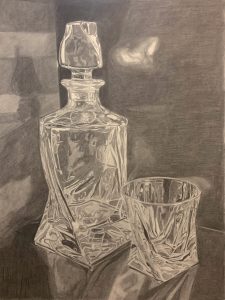
Whisky glass and decanter. Graphite, 18″x24″, 2020.
Similarly, this piece is something you would see as promotional material or advertisement, but the composition was created by me. I took upwards of 50 photos to find decent composition and lighting, which is reflective of my iterative process. This project took me upwards of 25+ hours over the course of three days, and despite being detrimental to my health, I had to finish it. I cannot stand to leave things unfinished or put off for too long. Doing so would prevent me from working on new projects.
Simply put, I want to finish things and I want things to look pretty to me. I want to be proud of the work I do, after committing time and myself to it. Because of my commitment to having an aesthetic piece that is finished, I have to carefully select a composition and subject matter that I can stick with.
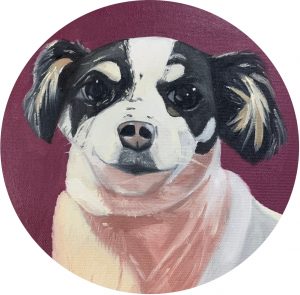
Dezi. Oil Paint, 8″ Circle Canvas, 2020.
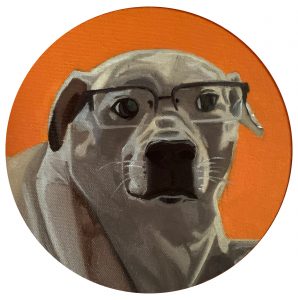
Minnie. Oil Paint, 8″ Circle Canvas, 2020.
These dog portraits were made for fun and as gifts for friends and family. Although I had no need to iterate with these pieces since I used a reference image, I still made a large thumbnail to make sure I had the best chance at success on the canvas. Despite being different from my studio work, these portraits also do not have a deeper meaning. They are simply to create something that looks nice for people I care about.
I recently read about the Aesthetic Movement, which flourished in England in the late 1800s. The idea was to create “‘art for art’s sake'”, and to focus more on the beauty of a piece more than its deeper meaning. This was a rejection of putting social and political ideology and reasoning onto artwork, whether intentional by the artist or from external sources (Aestheticism). I mostly agree with the idea of Aestheticism. I don’t really create things for a certain purpose except for beauty.
Works Cited
Aesthetic. (n.d.). Retrieved October 16, 2020, from https://www.merriam-webster.com/dictionary/aesthetic
Aestheticism. (2020, October 15). Retrieved October 23, 2020, from https://en.wikipedia.org/wiki/Aestheticism
Completeness. (n.d.). Retrieved October 23, 2020, from https://www.merriam-webster.com/dictionary/completeness
My realistic drawings, pet portraits, abstract works, and digital design come together through logical and simplistic choices that are shaped through my note-taking and iterative process. Documenting my creative process is the best thing I’ve ever done. I can always look back and see both my finished works, as well as the ideas that led me there. It’s easy to forget how you got to that final stage if that’s all you have left. I feel confident to explore new materials and mediums because I approach them the same way I would with one I am familiar with.
Media Attributions
- cinnamon_tea © Sylvia Jurgens is licensed under a CC BY (Attribution) license
- sustainability_thumbnail © Sylvia Jurgens is licensed under a CC BY-NC-ND (Attribution NonCommercial NoDerivatives) license
- flag_project_thumbnail_2 © Sylvia Jurgens is licensed under a CC BY-NC-ND (Attribution NonCommercial NoDerivatives) license
- flag_project_thumbnail_1 © Sylvia Jurgens is licensed under a CC BY-NC-ND (Attribution NonCommercial NoDerivatives) license
- flag_project_thumbnail_3 © Sylvia Jurgens is licensed under a CC BY-NC-ND (Attribution NonCommercial NoDerivatives) license
- Thumbnail1 © Sylvia Jurgens is licensed under a CC BY-NC-ND (Attribution NonCommercial NoDerivatives) license
- Thumbnail2 © Sylvia Jurgens is licensed under a CC BY-NC-ND (Attribution NonCommercial NoDerivatives) license
- vilevia_logo_cropped © Sylvia Jurgens is licensed under a CC BY-NC-ND (Attribution NonCommercial NoDerivatives) license
- 2am_movies_logo © Sylvia Jurgens is licensed under a CC BY-NC-ND (Attribution NonCommercial NoDerivatives) license
- 2AM_Style_Dev. 1 © Sylvia Jurgens is licensed under a CC BY-NC-ND (Attribution NonCommercial NoDerivatives) license
- 2AM_Style_Dev. 2 © Sylvia Jurgens is licensed under a CC BY-NC-ND (Attribution NonCommercial NoDerivatives) license
- 2AM_Color_Dev. © Sylvia Jurgens is licensed under a CC BY-NC-ND (Attribution NonCommercial NoDerivatives) license
- completed_sustainable materials_project © Sylvia Jurgens is licensed under a CC BY-NC-ND (Attribution NonCommercial NoDerivatives) license
- japanese_american_flag © Sylvia Jurgens is licensed under a CC BY-NC-ND (Attribution NonCommercial NoDerivatives) license
- jurgens_sylvia_390_6d_large_original_revised © Sylvia Jurgens is licensed under a CC BY-NC-ND (Attribution NonCommercial NoDerivatives) license
- jurgens_sylvia_390_7b_large_original_revised © Sylvia Jurgens is licensed under a CC BY-NC-ND (Attribution NonCommercial NoDerivatives) license
- Dezi_Cropped © Sylvia Jurgens is licensed under a CC BY-NC-ND (Attribution NonCommercial NoDerivatives) license
- minnie_painting_cropped © Sylvia Jurgens is licensed under a CC BY-NC-ND (Attribution NonCommercial NoDerivatives) license

